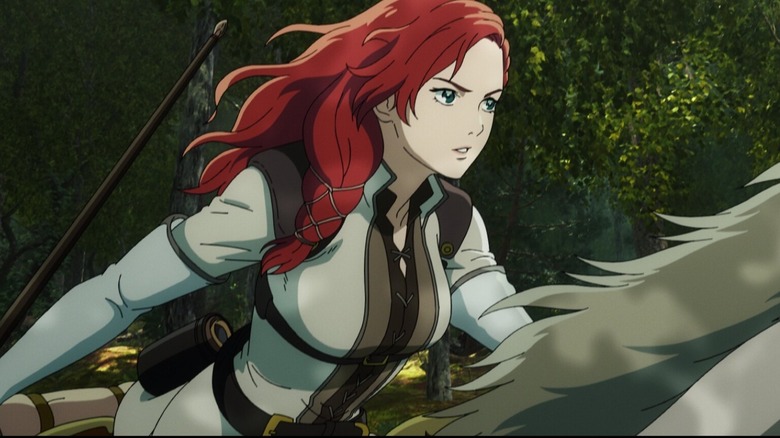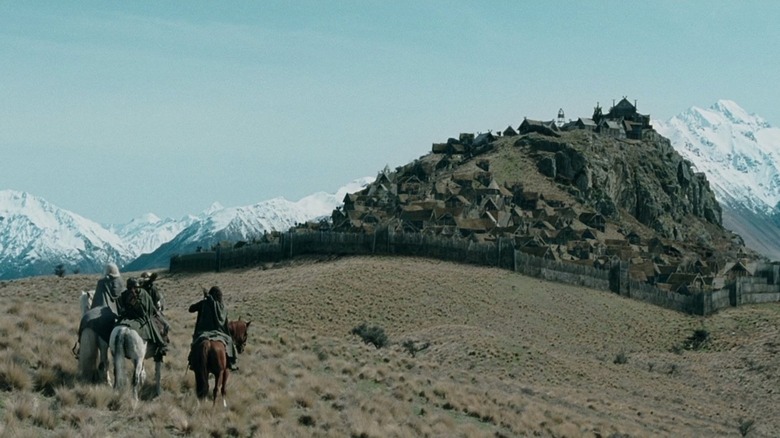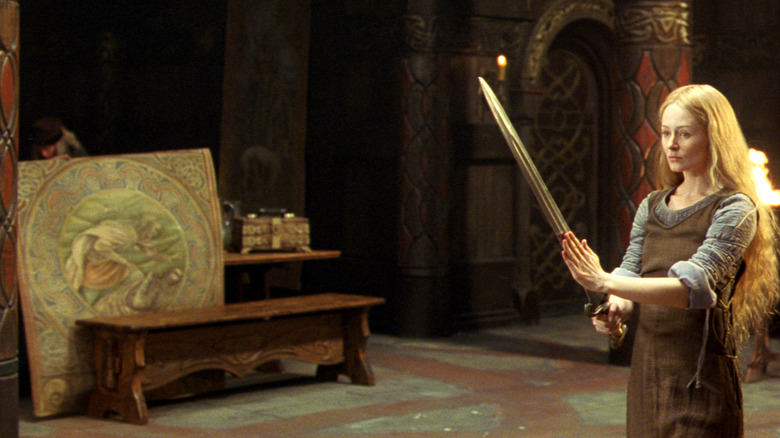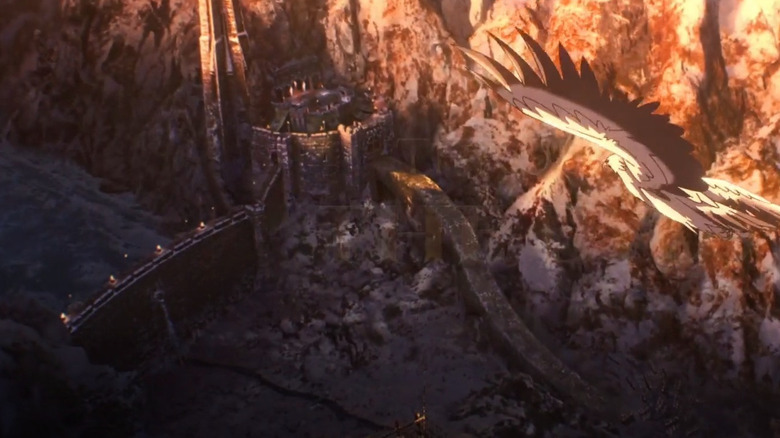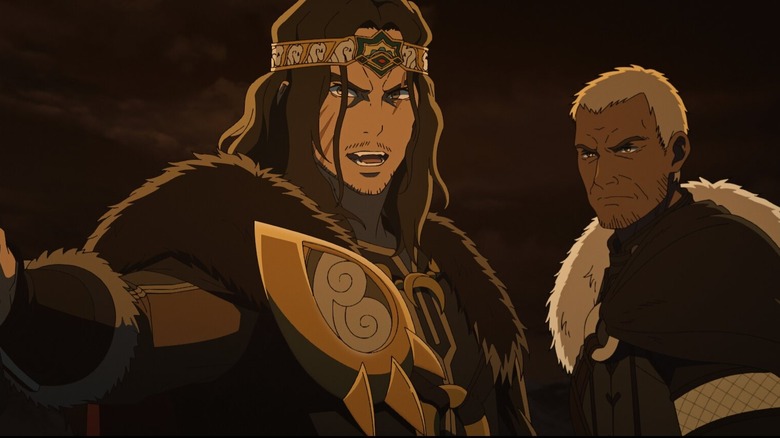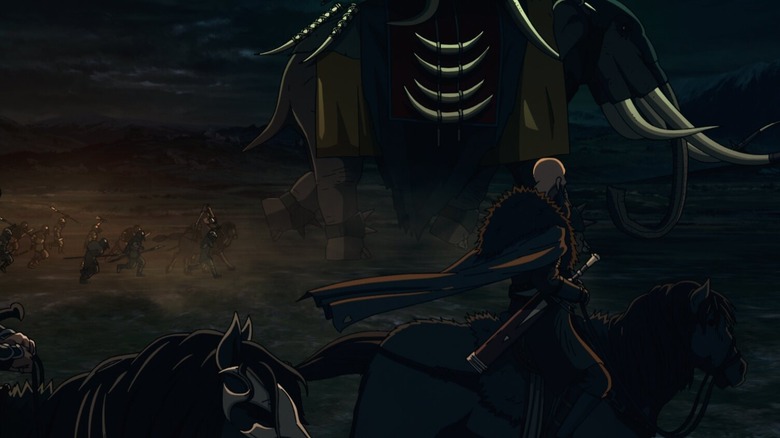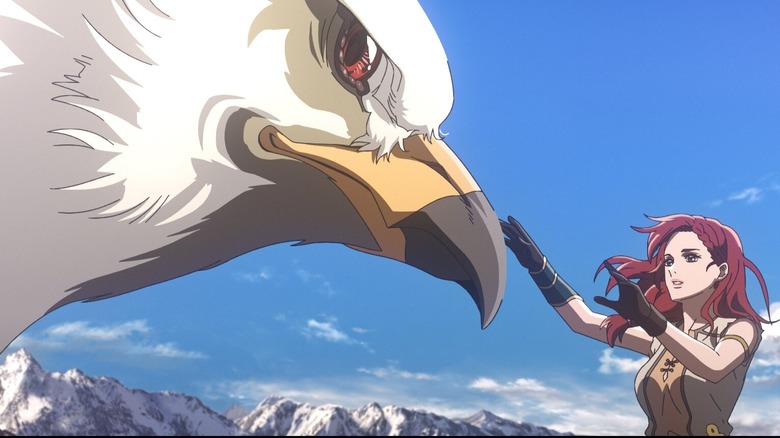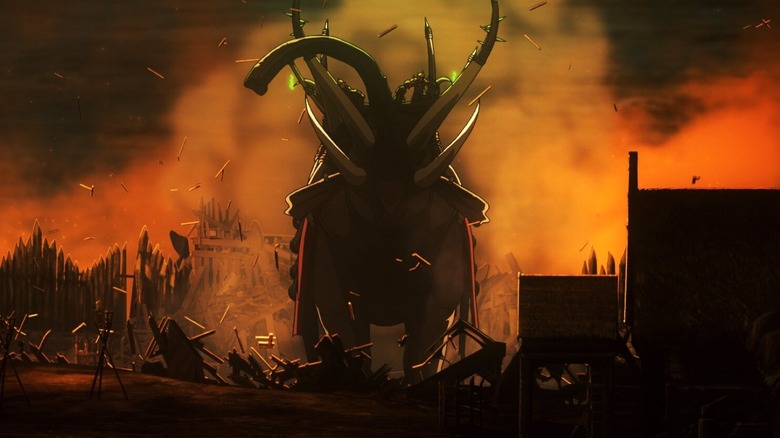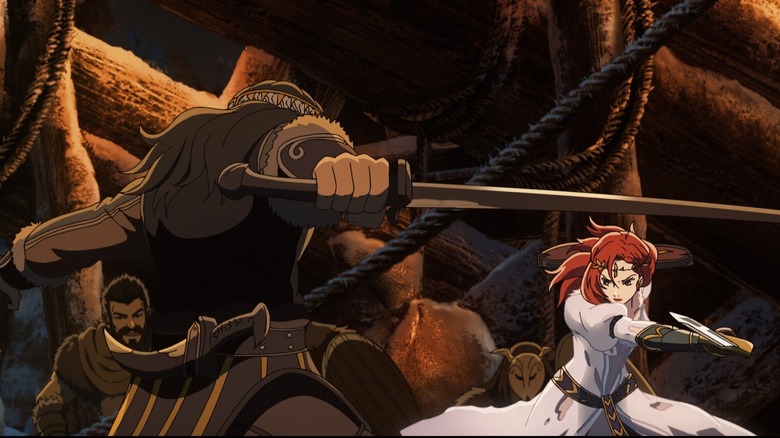8 Hidden Details You Missed In The Lord Of The Rings: The War Of The Rohirrim Trailer
Before "The Lord of the Rings" and before "The Hobbit," there was "The War of the Rohirrim." Merely the first of several new "Rings" movies currently in the pipeline, this animated film is set to bring J.R.R. Tolkien's beloved fantasy world to life like we've never seen it before — reinterpreting Middle-earth and its entire iconography through the heightened magic of anime. Warner Bros. debuted the official full-length trailer earlier today after only releasing snippets of footage at exclusive events over the last few years, finally giving animation fans and Tolkien nerds alike plenty of reason to join forces in anticipation of this next grand adventure. The epic tale is set almost 200 years before the events of the original "Lord of the Rings" trilogy, chronicling a key moment from the history of Rohan and its horse-riding people: the legendary tale of Helm Hammerhand and his war against the marauding Dunlendings.
As with any piece of media related to the franchise these days, however, attention and scrutiny tend to run rampant; and that's certainly no different when it comes to "The War of the Rohirrim." Even beyond the novelty of having an artist as talented as Japanese director Kenji Kamiyama take the reins, the upcoming anime represents a nigh-unprecedented exploration into distant Middle-earth history. Even the biggest Tolkien fans couldn't have anticipated that our first "The Lord of the Rings" movie in a decade would center on this particular slice of lore, let alone the fact that the trailer would come jam-packed with as many deep-cut details as it does. From newcomers to diehards and everyone in between, there's truly something for every type of fan here.
Without further ado, here are our eight biggest takeaways from this "The War of the Rohirrim" trailer footage.
Howard Shore's score
Try as we might, there's simply no outdoing the greats. The reputation and legacy of "The Lord of the Rings" movies speaks for itself at this point, with the trilogy marking a seminal moment in blockbuster history in terms of craft, cultural impact, and far too many other aspects to count. But as undeniably great as the cast and Peter Jackson's direction may have been, one element above the rest helped put the series among the all-time greats: the brilliant, unforgettable score by composer Howard Shore. All it takes is hearing a few specific notes of his music and, chances are, you'll be instantly transported to any number of moments from the films. It's no wonder that Prime Video's "The Rings of Power" series hasn't even tried to get out from under Shore's influence, going so far as to recruit him for the opening credits sequence.
That influence is immediately on display in today's footage, opening with Shore's horn-heavy motif for the realm of Rohan that he first introduced in "The Two Towers" and further developed through to "The Return of the King." Obviously, that choice was made to maximize the nostalgic impact of seeing fan-favorite characters like Aragorn, Legolas, Gimli, and Gandalf once more. At the same time, it helps ground viewers in the fact that this new film will, in fact, take place in the same continuity as those prior films (unlike "The Rings of Power," which is clearly influenced by Jackson's movies but otherwise remains separate). But it also speaks to the lasting legacy of the originals, acting as a sort of acknowledgement that the standards remain sky high and that everyone involved in "The War of the Rohirrim" is standing on the shoulders of greatness.
You've heard (and seen) that narrator before
She's a daughter of kings, a Shieldmaiden of Rohan, and, now, the primary narrator of "The War of the Rohirrim." For the first time since 2004's "The Return of the King," actor Miranda Otto reprises her original role as the warrior Éowyn. Fans know her as the offspring of King Théoden (played by the late Bernard Hill) and sister of Karl Urban's Éomer, though her impact on pop culture goes much further than that. In an almost word-for-word recreation of Tolkien's own writing, "The Return of the King" cemented the hero as a feminist icon when she waded into battle (directly against the strict traditions of the male-oriented culture of the Rohirrim), announced that she is no man after all, and managed to slay the fearsome foe known as the Witch-king in one of the most famous moments of the entire trilogy. Her presence is a welcome (if unseen) one in "The War of the Rohirrim," providing crucial connective tissue with the original movies.
As a narrator, her role instantly puts the film in proper context. The story of Helm Hammerhand (voiced by Brian Cox) is being retold by Éowyn as a fireside myth either during or long after the events of "The Lord of the Rings," possibly to a whole new generation of Rohirrim. And, based on the footage, it won't be much of a stretch to see the parallels between herself and the main protagonist Héra (Gaia Wise) — who is also, not coincidentally, an ambitious warrior and daughter to a king.
Helm's Deep looks just like new
Look, I get it. Not everyone can be expected to set aside the time to marathon the "Lord of the Rings" trilogy (and the extended editions, at that) at least once a year and definitely every holiday season like clockwork. Everyone absolutely should be doing so, to be clear, but that's a soapbox for another day. All this to say that it's understandable if anyone reading this isn't fully brushed up on the finer details of the movies, particularly when it comes to the look and layout of the fortress known as Helm's Deep. This castle hewn out of the surrounding mountain served as the main setting of the battle seen in "The Two Towers" (though, ironically, this epic-sized sequence took all of a chapter in the actual book) and returns in "The War of the Rohirrim" at a time when it hadn't yet earned its reputation as a savior to the people of Rohan.
In effect, the anime film is an origin story for how Helm's Deep got its name in the first place. Spoiler alert: it has to do with the feats performed by Helm Hammerhand and his actions when his family takes refuge in this very same castle. "The Two Towers" actually includes drips and drabs of this legend throughout the film, but never before has this tale been told in full ... until now, of course. For now, the footage makes it clear that this version of Helm's Deep looks exactly as it did in "The Two Towers," though not nearly as aged and worn down. In a neat wrinkle, we're about to find out why this location was so important to the people of Rohan in the first place.
Who exactly are the Dunlendings?
Every story needs its villains and, boy howdy, does "The War of the Rohirrim" feature some formidable foes for our heroes to deal with. The trailer quickly establishes Helm Hammerhand, his daughter Héra, and their uncomfortable run-ins with the people known as Dunlendings, who hail from the region of (you guessed it) Dunland. From Tolkien's writings, we know that Helm comes into conflict with a Dunlending known as Freca (voiced here by Shaun Dooley), who conspires to arrange a marriage between his sullen son Wulf (Luke Pasqualino) and his childhood friend Héra in order to seize even more power throughout the realm. When threats turn into full-blown fighting, a single punch thrown by Helm kills Freca where he stands and sets off Wulf's ugly quest for vengeance.
All this is laid out for us in the new footage, but what it doesn't show is the fact that we've actually seen these Dunlendings before — or, rather, their descendants. In "The Two Towers," a renegade group of "Wild Men" ravage the countryside of Rohan, empowered by the fallen wizard Saruman and whipped into a fury to reclaim their "stolen" lands from the horse-lords. Well, these roving bands count those very same Dunlendings as their ancestors and, yeah, they certainly know how to hold a grudge. Consider this an origin story of sorts for the Dunlendings, as well, charting how and why they have never gotten along with the Rohirrim.
The Mûmakil controversy
Okay, so this is less of a "hidden" detail and more like one that you couldn't possibly have missed, but I'm sure you'll forgive me for dedicating an entire portion of this article to some of the coolest creatures ever conceived by Tolkien. The Mûmakil (or oliphaunts, as they're also known) are the very definition of gentle giants — or would be, if terrible people would stop enslaving them and using them as larger-than-life war machines for insidious purposes. The obsession of the Hobbit Samwise Gamgee, the Mûmakil have passed into legend by the time of "The Lord of the Rings," though they would soon prove to be alive and kicking when the men of Haradrim recruited them as war oliphaunts in battle in both "The Two Towers" and most famously in "The Return of the King."
Now, to take a step off the beaten path and forge into total nerdery for a moment, their inclusion in "The War of the Rohirrim" has actually been a source of contention among the diehard fans. There is no specific record in Tolkien's account (found in the appendices included at the end of "The Return of the King") of oliphaunts being used in Wulf's war against Rohan, making this an example of artistic license in order to increase the spectacle. But, as laid out in this article on TheOneRing.net, it's known that the Haradrim eventually end up joining the Dunlendings in their siege. Traditionally, the Mûmakil have only ever been living tools of the Haradrim, so it stands to reason that they'd bring these beasts along.
Also, they're just plain cool.
The Eagles are coming!
If there's one thing that Tolkien is going to do, it's include giant Eagles in his stories whenever possible. The wise and noble birds play an important role in both "The Lord of the Rings" and "The Hobbit," arriving as sort of a deus ex machina to save our heroes at just the right time again and again. Similarly to the Mûmakil, however, there is actually no mention of Helm Hammerhand or Héra getting involved with these creatures during their war against the Dunlendings, though they feature prominently throughout the trailer. This, however, lines up with an early feature from The Wrap that described the character of Héra as "a headstrong young woman" who "rides horses and who communes with the Great Eagles." That bond is readily apparent and further hints at our hero's innate strength of character. It remains to be seen if this sentient race will actually involve themselves in the war itself, directly intervening the way they did in the war against the Dark Lord Sauron — first to help Gandalf out of a bind on multiple occasions, and again at the Black Gates of Mordor to whisk Frodo and Sam away to safety after destroying the One Ring. But, if nothing else, it's easy to see them representing a major running theme of the natural world and how the actions of the ignorant can affect even the most ancient of beings.
Attack of the swamp thing?
This might be the strangest imagery on display in the entire trailer. At one point, we see Héra running for her life from a rogue oliphaunt (presumably a different one than the creature pictured above) that's chasing her down in some vast wilderness. When she finds herself in a swamp, she's only saved when another frightening creature suddenly attacks from the muck and ensnares the Mûmakil with its creepy-looking tendrils. There's the briefest of overhead shots that shows what this perplexing action sequence looks like from a distance, but otherwise we're left to guess exactly what's going on here and what that swamp monster is supposed to be. Tolkien's legendarium describes all sorts of evil and unfriendly beasts hidden throughout Middle-earth, but the only one that even vaguely fits the description of this particular one would be the Watcher in the Water. This enemy is seen in "The Fellowship of the Ring," when our main characters travel to the Mines of Moria and end up at the mercy of this tentacled monster from the deep. Even 200 years before this happens, it doesn't make a ton of sense that Héra would encounter the same (or a similar) creature, but we're as eager as you are to find out more about this one mystifying scene.
Return of the rings?
For those of you expecting some actual rings to show up in this "The Lord of the Rings" movie, pick up your no-prize here. It wouldn't have felt quite right for "The War of the Rohirrim" to close things out without at least teasing one significant reference to the main story, and clearly the creative team behind the film felt the same way. After all the war imagery and palace intrigue, the footage builds to one last crescendo. A mysterious figure tosses a ring into a pouch and, with a gravelly and downright evil-sounding voice, intones: "What does Mordor want with rings?"
Weird, huh? In this instance, we're left to ponder exactly how this is supposed to tie together with the world-ending threat of Sauron and his rings that will eventually appear (or, more accurately, reappear) on Middle-earth's shores almost 200 years from this point. The tone and framing of this quick shot feels like it's meant to evoke the visuals of the Ringwraiths, but the dialogue doesn't quite line up with that guess. (For one thing, the chief servants of Sauron would absolutely know what their master would want with rings of power.) Curiously, the actual trinkets all seem to be hastily gathered from all sorts of different places and materials, as if whoever this is merely heard that the lord of Mordor wants rings but otherwise has no idea what to look for.
Chalk this up as yet another mystery that we can't wait to see resolved when "The War of the Rohirrim" hits theaters on December 13, 2024.
